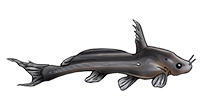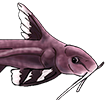Possible Illness
Possible Illness
Hello everyone, I have recently been dealing with my Hoplisoma similis wasting away. I lost the one pictured today and want to prevent any further deaths. I have also noticed my duplicareus have become thinner, especially behind the anal fin. No red splotches have been spotted on any of the fish either alive or post mortem.
1. Water parameters
a) 74F
b) pH ~6.9
c) GH Unknown, don't have a test for it at the moment
d) KH Unknown, don't have a test for it at the moment
e) TDS around 150
f) Ammonia 0, Nitrate 5, Nitrite 0
g) Water change frequency 60% weekly
h) Use prime for water changes but no other additives
2. Tank set up
a) 20 Gallon Long
b) Substrate None
c) Filtration Hamburg Matten Filter
d) Furnishings Driftwood and live plants
e) Other tank mates Around 16 other corydoras and related (duplicareus, similis, and fuscoguttatus)
f) How long has it been set-up? Tank has been setup for around 1 and 1/2 years
g) Nothing recenlty has changed to my knowledge, but it almost seems like any of the corydoras are adding weight and are possibly getting skinnier. The similis have definitely started to 'waste' away and I am now concerned for my group of duplicareus.
3. Look malnourished and appear to waste away over time. All of these fish I have had for at least 8 months or more and yet, they don't seem to grow as they should. Never encountered anything like this myself, but I suspect internal parasites of some sort, based on what I have read.
4. I have not tried any treatments as of yet, but I have begun to change the water more than once a week and fed more bloodworms.
5. No medications yet, but that is what I wanted to know if I should try to stop this or prevent other fish from getting it.
a) 74F
b) pH ~6.9
c) GH Unknown, don't have a test for it at the moment
d) KH Unknown, don't have a test for it at the moment
e) TDS around 150
f) Ammonia 0, Nitrate 5, Nitrite 0
g) Water change frequency 60% weekly
h) Use prime for water changes but no other additives
2. Tank set up
a) 20 Gallon Long
b) Substrate None
c) Filtration Hamburg Matten Filter
d) Furnishings Driftwood and live plants
e) Other tank mates Around 16 other corydoras and related (duplicareus, similis, and fuscoguttatus)
f) How long has it been set-up? Tank has been setup for around 1 and 1/2 years
g) Nothing recenlty has changed to my knowledge, but it almost seems like any of the corydoras are adding weight and are possibly getting skinnier. The similis have definitely started to 'waste' away and I am now concerned for my group of duplicareus.
3. Look malnourished and appear to waste away over time. All of these fish I have had for at least 8 months or more and yet, they don't seem to grow as they should. Never encountered anything like this myself, but I suspect internal parasites of some sort, based on what I have read.
4. I have not tried any treatments as of yet, but I have begun to change the water more than once a week and fed more bloodworms.
5. No medications yet, but that is what I wanted to know if I should try to stop this or prevent other fish from getting it.
-
dw1305
- Posts: 1107
- Joined: 22 Oct 2009, 11:57
- Location 1: Corsham, UK
- Location 2: Bath, UK
- Interests: Natural History, Ecology, Plants, Biotopes, Taxonomy, Nitrification, Cricket & Northern Soul
Re: Possible Illness
Hi all,
cheers Darrel
Why don't you have sand as a substrate? I'm not a fan of "bare bottom".
cheers Darrel
- TwoTankAmin
- Posts: 1506
- Joined: 24 Apr 2008, 23:26
- I've donated: $4438.00!
- My cats species list: 6 (i:0, k:0)
- My BLogs: 2 (i:0, p:30)
- Location 1: USA
- Location 2: Mt. Kisco, NY
- Interests: Fish and Poker
Re: Possible Illness
There are times where a bare bottom is an asset. This is one of them because it allows us to see the fish poop and makes it easier to see if there is uneaten food. usually, a bare bottom tank is best for Hospital and often Quarantine use.
As for the fish wasting here:
Dr. Harrison sells Flubendazole here http://www.inkmkr.com/Fish/ItemsForSale.html if you feel it is appropriate to use for the problem here.
As for the fish wasting here:
The above is from http://www.inkmkr.com/Fish/FlubendazoleArticle.pdfEradicating Hydra and Other Pests with Flubendazole
From: Journal of the American Killifish Association September/October 2003
Vol.36, No. 5
By Charles Harrison, Ph.D.
This article is first about hydra and its eradication. Secondly, it is about a lot of relief from some of the most hideous afflictions of tropical aquarium fish, including wasting disease, which is often associated with the presence of Hexamita, a protozoan parasite, and velvet disease, a common scourge of captive killifish which is associated with the presence of Oodinium or Oodinium-like organisms.............
Several people from the AKA’s “KillieTalk” e-mail list recommended Flubendazole for treatment1. Flubendazole is an intestinal worm killer, an anthelmintic or vermicidal drug that destroys or dispels parasitic roundworms and tapeworms and seems to be an effective treatment against at least this one Cniderian. The recommended dosage was /2-teaspoon of 5% powder in 30 gallons of water. This dosage totally wiped out the hydra in about three days…goodbye hydra!
The hydra-killing Flubendazole that I used in my office aquarium to eradicate hydra led me to a larger realization. The “wasting” fish in that tank seemed to become cured when I added Flubendazole to the water. Whoa! This was quite a remarkable revelation. My intent was to remove the hydra and any possible nematodes and, to my surprise, the disease I have found to be associated with a particular protozoan species was cured.
Dr. Harrison sells Flubendazole here http://www.inkmkr.com/Fish/ItemsForSale.html if you feel it is appropriate to use for the problem here.
“No one has ever become poor by giving.” Anonymous
“Everyone is entitled to his own opinion, but not to his own facts.”" Daniel Patrick Moynihan
"The good thing about science is that it’s true whether or not you believe in it." Neil DeGrasse Tyson
“Everyone is entitled to his own opinion, but not to his own facts.”" Daniel Patrick Moynihan
"The good thing about science is that it’s true whether or not you believe in it." Neil DeGrasse Tyson
-
characinkid
- Posts: 199
- Joined: 02 Sep 2003, 22:02
- I've donated: $34.00!
- My cats species list: 10 (i:3, k:3)
- My aquaria list: 2 (i:0)
- My BLogs: 4 (i:3, p:165)
- My Wishlist: 5
- Spotted: 10
- Location 1: New England USA
- Location 2: NH USA
Re: Possible Illness
What are you feeding them? I sometime struggle to get enough food in my corys in a mixed community tank.
Too Many Tanks... Too Many fish... not enough time!!!
Re: Possible Illness
As TwoTank mentioned it definitely makes it easier to check poop and make sure I am able to clean up uneaten food when I do larger feedings. This is not a permanent setup per say, I intend to do species only tanks for all of them soon. These tanks will include sand eventually.
Thank you for the recommendation looks like I am going to have to give that medication a try. At someone else's suggestion, I dosed some Fritz Expel P before seeing this response (I need to check my replies more
As to the feedings, I tend to feed mostly Repashy Bottom Scratcher, which my fish cannot get enough of and I supplement with many other pellets, live food, and bloodworms. None of the fish I have witnessed have not been feeding.
Thanks again all, I will keep updating as I see improvement or not




